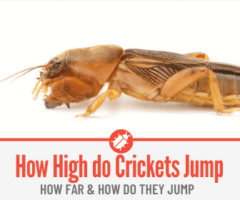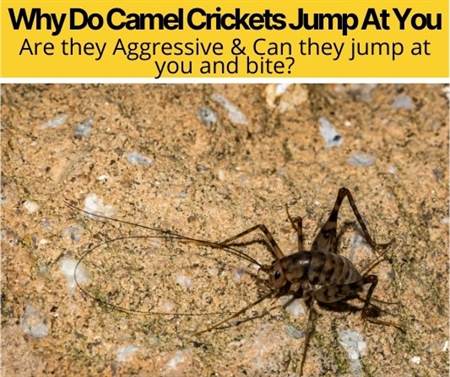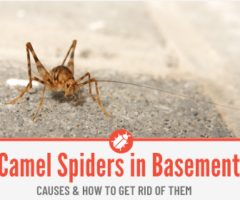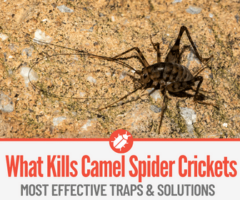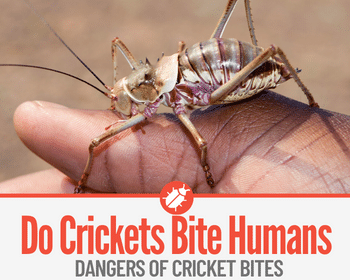 Have you ever wondered if the chirping crickets outside your nightly window are capable of a mighty chomp?
Have you ever wondered if the chirping crickets outside your nightly window are capable of a mighty chomp?
In this guide you will learn:
- If Crickets can Bite Humans & How exactly do they bite,
- Dangers of Cricket Bites & Diseases you can get if handling crickets,
- Comparison Between Different Crickets and their Biting Abilities.
Crickets do bite and do have two multipurpose jaws for biting and chewing, but you are safe from their wrath as their combs of teeth are not sharp enough to puncture the skin.
Do Crickets Bite Humans?
Yes, crickets do bite and have been known to bite humans, however their mouths are not sharp enough to cause you any physical danger.
Their diets mainly consist of dead insects or cardboard and clothes which may explain the lack of strength in their mouths needed for their diet.
Therefore, the size of the cricket often effects the intensity of their bite, the bigger the cricket the more you will feel the bite.
There are only specific types of crickets known for their bites, such as house crickets, black field cricket, Jamaican field crickets and crazy red crickets. These crickets are known for their nasty bites.
Why Do Crickets Bite?
They dislike it if they are handled tightly which may cause them to bite you.
As like many other animals, they do not like to be or feel threatened and so may bite as a defence mechanism, if they are constricted too intensely.
Some Crickets are also more aggressive than others, so might bite you even if you only try to touch them.
Here’s how they bite…
Crickets actually have between fifty and three hundred teeth, arranged in a comb shape in their mouths.
These are essential for the chirping noise as they brush the upper hind edge of their wind against the comb of teeth, which makes the noise. Similar to the noise a comb makes if you dragged your finger down the bristles vertically!
Each species of crickets has its own unique chirp and there are over 900 species!
This is how crickets do have the capability to bite as they do actually possess teeth, however usually they lack the strength to have a harmful impact.
Cricket Bite Symptoms
Although cricket bites are infrequent and rare, they can leave painful sores on the surface of your skin.
Diseases can also develop, consequently of being bitten or coming into physical contact with their faeces.
Symptoms of these bites mostly resemble an itchy red sore that could inflame or swell the hand or infected area.
They can also sting and sometimes crickets may also pinch you, which may react negatively with your skin.
You can also contract flu-like symptoms.
Can Crickets actually Hurt You?
Their mouths aren’t usually strong enough to physically penetrate the skin so they cannot necessarily hurt you.
Bigger crickets are more likely to be able to hurt you, causing a skin reaction or rash.
Crickets do not sting or contain/inject any venom as they do not have stingers. There is a Field cricket that has a long antenna looking like a stinger, but it is infact something they use to lay their eggs.
If you are wondering if there are actually any poisonous crickets…
Crickets aren’t poisonous and are barely even harmful, however they are invasive pests that can be damaging to the property as well as making lots of continuous noise.
There are no poisonous crickets, and no crickets can sting you either as crickets do not have stingers. It is also highly unlikely to be harmed by them physically.
You can be cured from anything they may cause you, from the diseases or sores you may contract.
What Happens When a Cricket Bites You?
In the worst case it will most likely just cause you a bad or uncomfortable skin reaction which causes swelling or sores to appear and sometimes flu-like symptoms.
In terms of treatment, you may wish to wash your hands with warm water and anti-bacterial soap, as well as bacterial ointment if you get bitten by a cricket.
If this does not lift the sores from the skin, seek medical attention as a round of antibiotics may be required to treat the cricket bite.
Diseases Crickets can Carry
A cricket’s diet consists mainly of dead animals which makes it very easy for them to pick up parasites and therefore easy for them to carry and spread disease.
You can pick up the diseases crickets carry through contact with their faeces or possibly through their bites.
The parasites they carry in their excrement and body carry E. coli and salmonella which could be potentially very dangerous to humans.
They also have the capability to carry worms.
It is easier for them to pass disease to animals than to humans, which means that if you feed infected crickets to your pets, they can also become diseased.
You can pick up bacterial infection from crickets, but antibiotics should cure it, if administered by a doctor.
If you think you may have been bitten by a cricket and get any symptoms matching those of salmonella or E. coli it is best to seek professional medical advice.
Comparison between Crickets
Mole Crickets
Mole Crickets been known to bite humans, but this is only if they are handled and feel constricted if the hold on them is too tight.
If you are wondering if Mole crickets are Poisonous …
They are not venomous or particularly harmful, they bite infrequently, and the reaction is often skin related, such as sores.
Black Crickets
Black crickets also do bite and can bite a human, they are especially known for their bites that can be quite nasty. This is as they are a generally larger breed of cricket and can have a more powerful bite.
However, being bitten is not a common occurrence so there is no need to worry if you are not handling and restricting them.
Jerusalem Crickets
Jerusalem Crickets are not prone to biting, but if handled it is not impossible that they may. It will also inflict relatively short-term pain.
House Crickets
House Crickets can bite and they do bite humans, however they do not have particularly strong mouths and it is unlikely for them to pierce the skin.
Mormon Crickets
Interestingly, Mormon crickets do not bite or carry disease or pose a threat.
However, that does not mean you should be tempted to handle them or keep them as pets!
But interestingly they do bite and eat each other as they are cannibals.
These guys also don’t have wings and so don’t fly but can jump and climb.
Banded Crickets
Banded crickets are known for their non-aggressive nature. These crickets are more common in Asia than the US, however. Banded Crickets are also not known to bite humans
Locusts
Locusts do bite and will bite you if you happen to pick one up. Locust bites can also be a painful experience, they are a cricket that is particularly well-known for its grumpy nature.
Grasshoppers
If you are wondering if Grasshoppers bite humans, then yes grasshoppers are capable of biting, but they are not harmful or dangerous or poisonous.
They do not usually bite but sometimes do when they are in their large swarms when invading. They can become very aggressive in that state.
In Conclusion
Crickets aren’t particularly harmful or dangerous, but their faeces can be harmful due to the diseases they carry.
They can also be harmful to your home however, by eating your clothes and making lots of noise.
Crickets are sometimes dangerous to humans when swarming, during this time whole swarms can cross the roads and cause obstructions, this can be very chaotic, and some swarms of crickets will be cannibalistic and try to eat one another.
They can also be harmful to humans by threatening their homes or agriculture.
Although they don’t harm humans directly, they can harm furniture or plants. Crickets are not usually inside homes, but they do consume furniture, fabrics, woods and carpet.


